Medieval Rabbit Stew
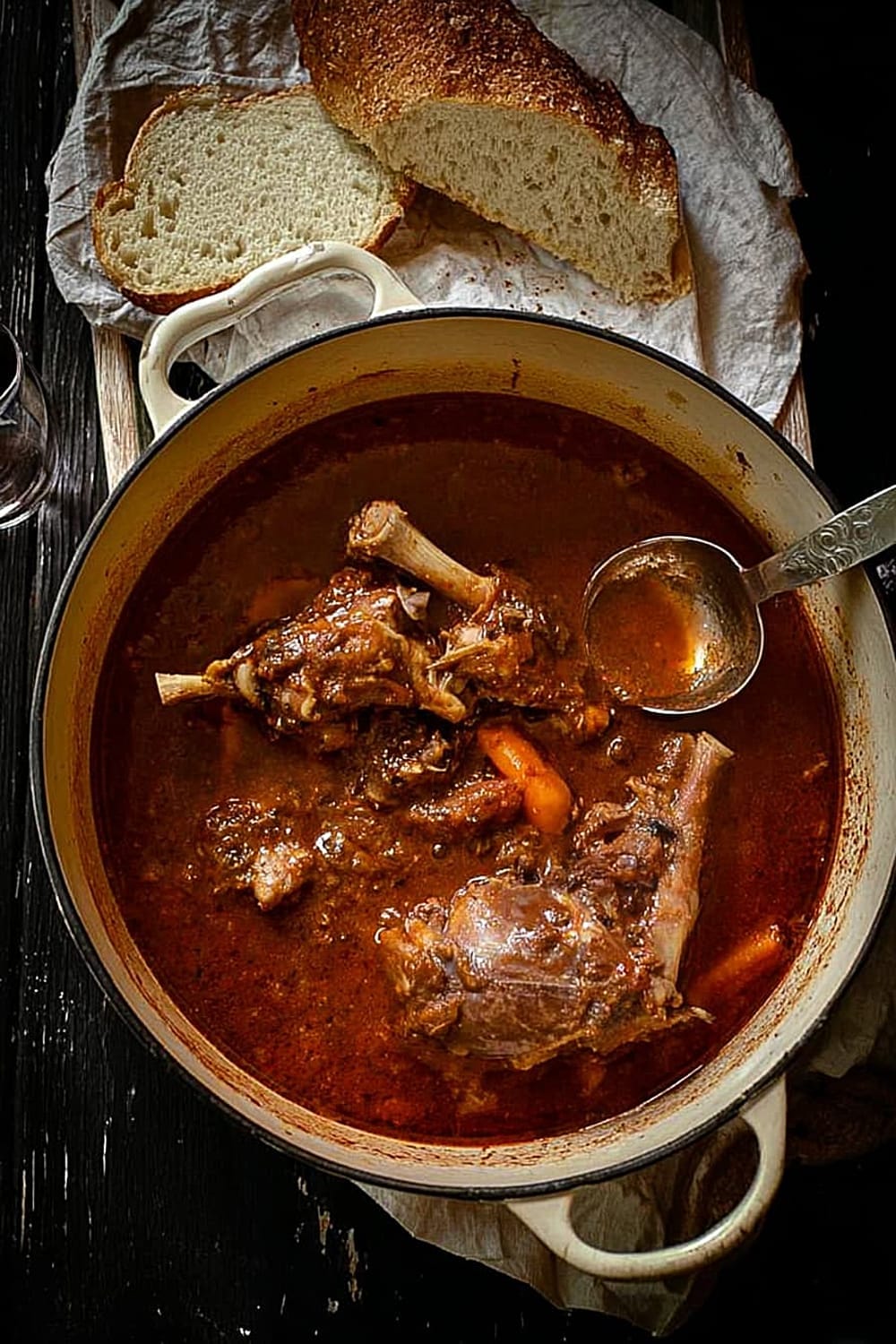
This medieval rabbit stew is basically your ticket to feeling like you could survive in a castle kitchen, minus the questionable hygiene and political intrigue.

The aroma alone will have your neighbors wondering if you’ve secretly been hiding culinary superpowers this whole time.

Picture tender rabbit meat that literally falls off the bone, swimming in a rich, wine-kissed broth that tastes like it’s been simmering in some ancient European countryside.

This isn’t your average weeknight dinner – it’s the kind of recipe that makes you feel like you should be wearing an apron and speaking in a British accent.
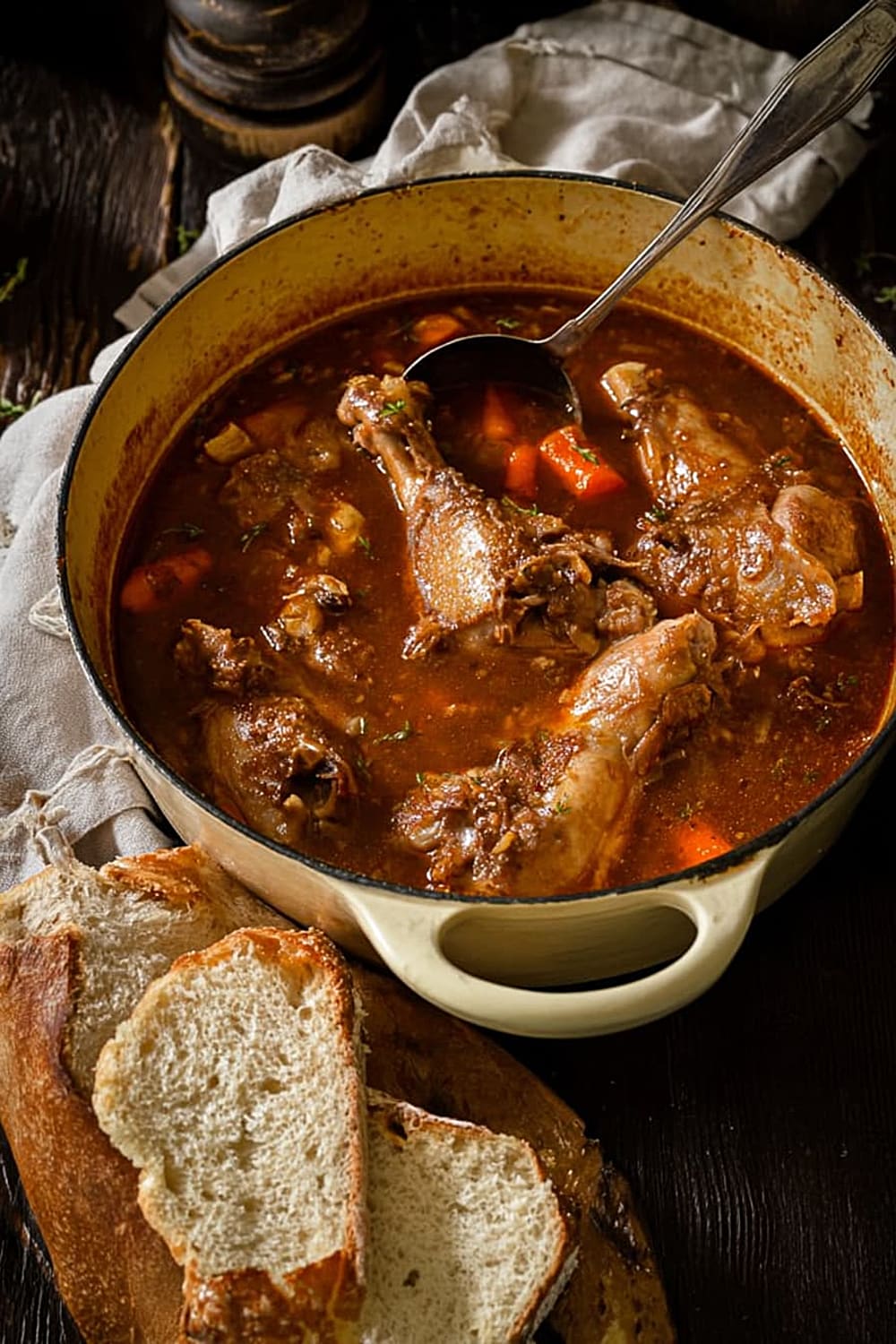
The combination of white wine, aromatic herbs, and slow-braised rabbit creates a depth of flavor that’ll make you question why you ever settled for chicken.

Fair warning: making this will result in people asking for the recipe, then immediately backing away when you mention the three-hour cooking time like it’s some kind of culinary commitment they’re not ready for.

Ingredients
For the Rabbit
- 1 rabbit (about 3 lbs in weight)
- 2 teaspoons salt (plus more to taste)
- 2 teaspoons pepper (plus more to taste)
For the Aromatic Base
- 1 large yellow onion, chopped
- 6 cloves garlic, minced
- 1 /3 cup olive oil
- 2 tablespoons butter
For the Vegetables
- 3 carrots, peeled and sliced
- 2 stalks celery, sliced
- 5 tomatoes, cut into eighths
- 1 tablespoon plus 1 teaspoon tomato paste
For the Braising Liquid
- 1 cup vegetable broth
- 1 /2 cup white wine
- 1 /3 cup white vinegar
For the Herb and Spice Blend
- 3 bay leaves
- 1 teaspoon dried oregano
- 1 teaspoon fresh oregano
- 1 /2 teaspoon allspice
- 1 /4 teaspoon cinnamon

Instructions
Prepare the Rabbit
- 1 Separate the rabbit into legs, ribs, arms, and thighs using a sharp knife or kitchen shears. Don’t worry about perfect butchery – this is rustic cooking at its finest. If you’re uncomfortable breaking down the rabbit yourself, ask your butcher to do this step, though learning this skill with a good pair of kitchen shears will serve you well for future game cooking adventures.
- 2 Rub the outside of each rabbit piece with 1 teaspoon salt and 1 teaspoon pepper, making sure to coat all surfaces evenly. The salt will help draw out moisture and create better browning later. Set the seasoned pieces aside on a large cutting board while you prepare your aromatics – this brief resting time allows the seasoning to penetrate the meat.
Build the Flavor Base
- 3 Heat 1/3 cup olive oil in a large, heavy-bottomed pot or cast iron Dutch oven over medium heat. You’ll know it’s ready when the oil shimmers slightly but doesn’t smoke. Using a cast iron skillet or enameled Dutch oven works particularly well here because of their superior heat retention, which is crucial for the long braising process ahead.
- 4 Add the chopped onions and minced garlic to the heated oil, sautéing until transparent and lightly browned around the edges, about 20 minutes, stirring every 5 minutes. This sounds like a long time, but patience here pays dividends – properly caramelized onions and garlic create the foundational sweetness that balances the wine’s acidity. The mixture should smell fragrant and the onions should be golden, not burnt.
Brown the Meat
- 5 Move the onion and garlic mixture to the sides of the pan, creating a clear space in the center. Add the seasoned rabbit pieces to this center space, arranging them in a single layer without overcrowding. Brown the meat on all sides, cooking for about 10 minutes total, turning pieces every 2-3 minutes. You’re looking for a deep golden-brown color that indicates proper caramelization – this Maillard reaction is what creates the complex, savory flavors that make this stew extraordinary.
Add Remaining Ingredients and Braise
- 6 Add the cut tomatoes, 1 tablespoon plus 1 teaspoon tomato paste, 1 cup vegetable broth, 1/3 cup white vinegar, 1/2 cup white wine, sliced carrots, sliced celery, 2 tablespoons butter, 3 bay leaves, 1 teaspoon dried oregano, 1/2 teaspoon allspice, 1/4 teaspoon cinnamon, and the remaining 1 teaspoon salt and 1 teaspoon pepper. Stir everything together until well blended, making sure the tomato paste is fully incorporated and not clumping.
- 7 Bring the entire mixture to a rolling boil over medium-high heat, which should take about 5-7 minutes. Once boiling, immediately lower the heat to achieve a gentle simmer – you should see small bubbles breaking the surface occasionally, not a vigorous boil that could toughen the meat.
Long, Slow Simmer
- 8 Cover the pot with a tight-fitting lid and cook for 2 1/2 to 3 hours, or until the rabbit meat is fork-tender and falls off the bone easily. Check every 45 minutes to ensure the liquid hasn’t evaporated too much – add more vegetable broth if needed to maintain the braising liquid level. The long, slow cooking process breaks down the tough connective tissues in the rabbit, transforming them into rich, silky gelatin that thickens the stew naturally.
- 9 Stir in the 1 teaspoon fresh oregano during the last 10 minutes of cooking. Taste the stew and adjust seasoning with additional salt and pepper until it reaches your personal preference. Remove the bay leaves before serving – they’ve done their aromatic work and aren’t meant to be eaten.
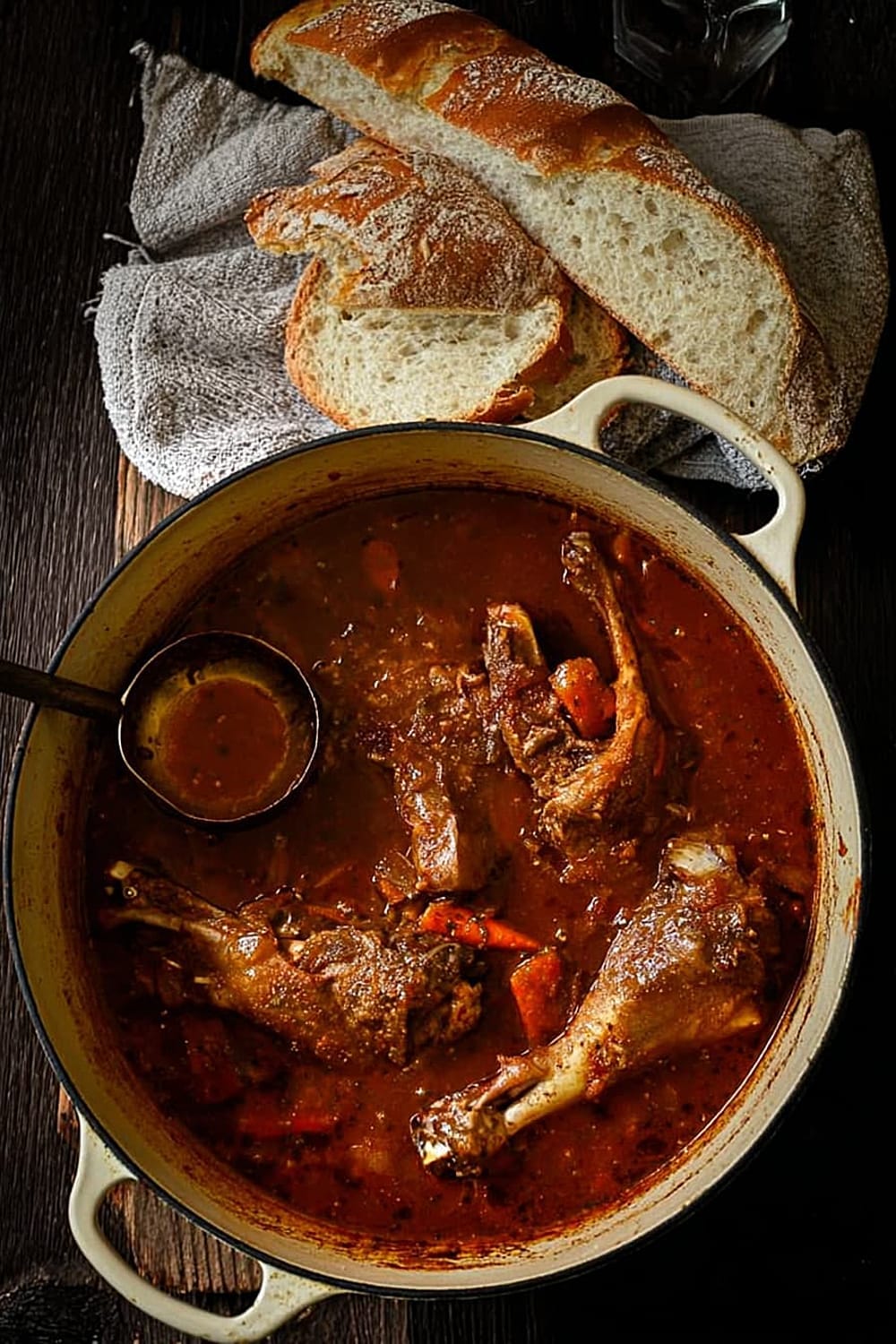
Recommended Equipment and Kitchen Tools
Recommended Tools (for best results):
- Heavy-bottomed Dutch oven or cast iron pot – Essential for even heat distribution during the long braising process. The thick bottom prevents hot spots that could cause burning, while the tight-fitting lid retains moisture perfectly for tender results.
- Sharp chef’s knife or kitchen shears – Breaking down the rabbit requires clean cuts through joints and bones. A quality knife makes this process safer and more efficient, though kitchen shears can be easier for beginners to handle.
- Instant-read thermometer – While this recipe relies on visual and texture cues, a thermometer helps ensure the internal temperature reaches 160°F (71°C) for food safety.
- Large cutting board – You’ll need ample space for breaking down the rabbit and prepping all the vegetables without cross-contamination.
Helpful Upgrades:
- Enameled cast iron Dutch oven – The gold standard for braising, offering superior heat retention and even cooking. Le Creuset or Staub are premium options, but Lodge makes excellent budget-friendly alternatives.
- Microplane grater – Perfect for zesting any citrus additions or grating fresh garlic when you want a more intense flavor than minced.
- Silicone-tipped tongs – Essential for safely turning the rabbit pieces during browning without piercing the meat and losing precious juices.
Nice-to-Have Options:
- Immersion blender – If you prefer a thicker stew consistency, you can partially blend the vegetables and broth while leaving the meat intact.
- Fine-mesh strainer – For an ultra-refined presentation, strain the braising liquid and serve it as a separate sauce alongside the meat and vegetables.
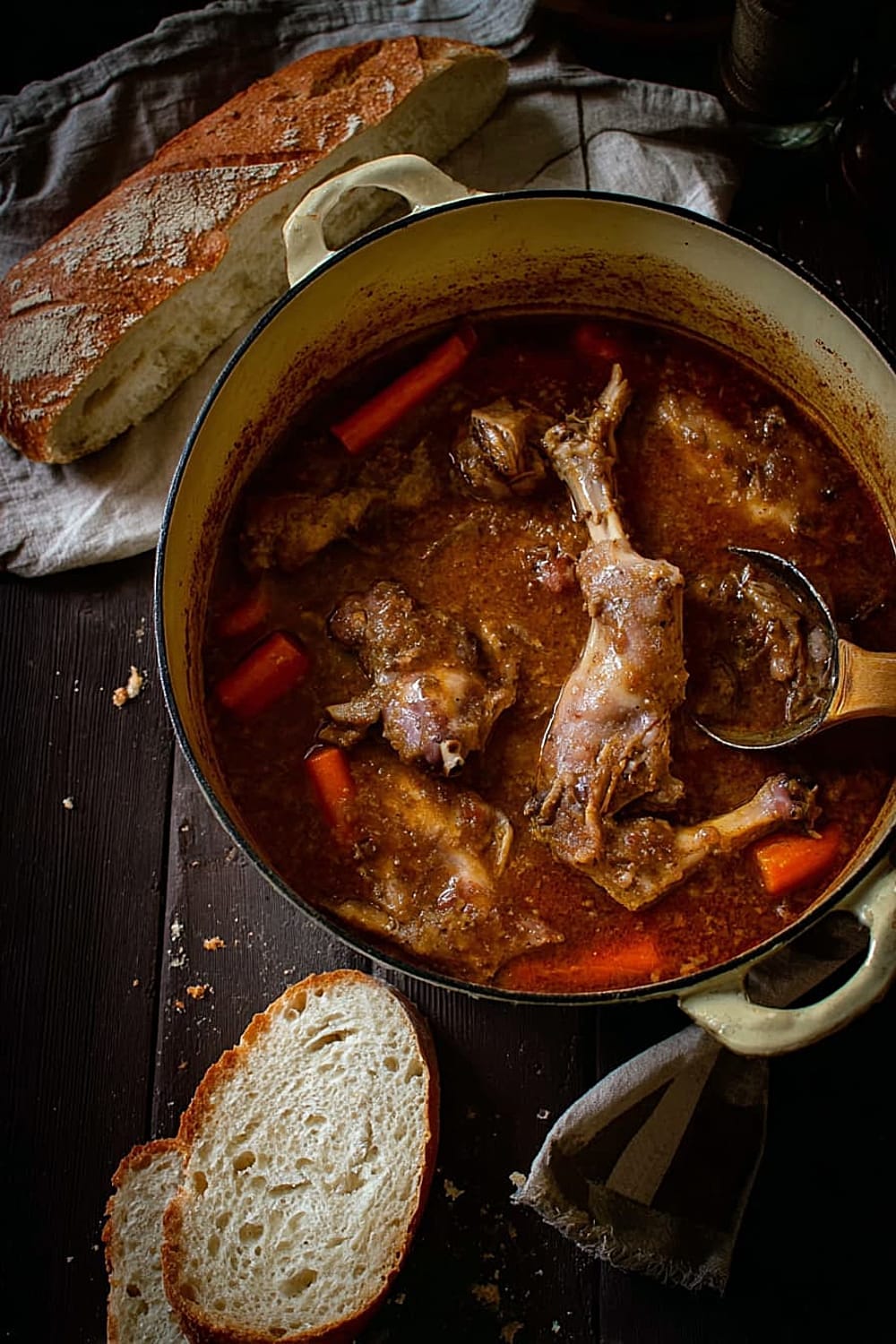
Recipe Variations and Dietary Modifications
Game Meat Substitutions:
- Chicken thighs → Use 3 lbs bone-in, skin-on chicken thighs, reduce cooking time to 1 1/2 to 2 hours. The dark meat provides similar richness to rabbit while being more accessible.
- Duck legs → Substitute 6-8 duck leg quarters, cook for 2 to 2 1/2 hours. Duck’s natural fat content creates an even richer stew with deeper flavor.
- Lamb shoulder → Use 3 lbs cubed lamb shoulder, maintain the same cooking time. The robust flavor pairs beautifully with the medieval spice blend.
Alcohol-Free Modifications:
- White wine → Replace with equal amount additional vegetable broth plus 2 tablespoons apple cider vinegar for acidity balance
- Enhance depth → Add 2 tablespoons white wine vinegar and 1 teaspoon sugar to mimic wine’s complexity
Vegetable Variations:
- Root vegetable medley → Add 2 parsnips, 1 large turnip, or 8 oz mushrooms for earthier flavors that complement the medieval theme
- Seasonal additions → Include 1 cup pearl onions in fall, 2 cups butternut squash in winter, or 1 cup fresh peas in spring
- Herb substitutions → Replace oregano with fresh thyme, rosemary, or sage for different aromatic profiles
Spice Blend Alternatives:
- French-inspired → Substitute allspice and cinnamon with 1 teaspoon herbes de Provence and 1/2 teaspoon fennel seeds
- Mediterranean twist → Add 1 teaspoon smoked paprika and 1/2 teaspoon dried rosemary instead of the sweet spices
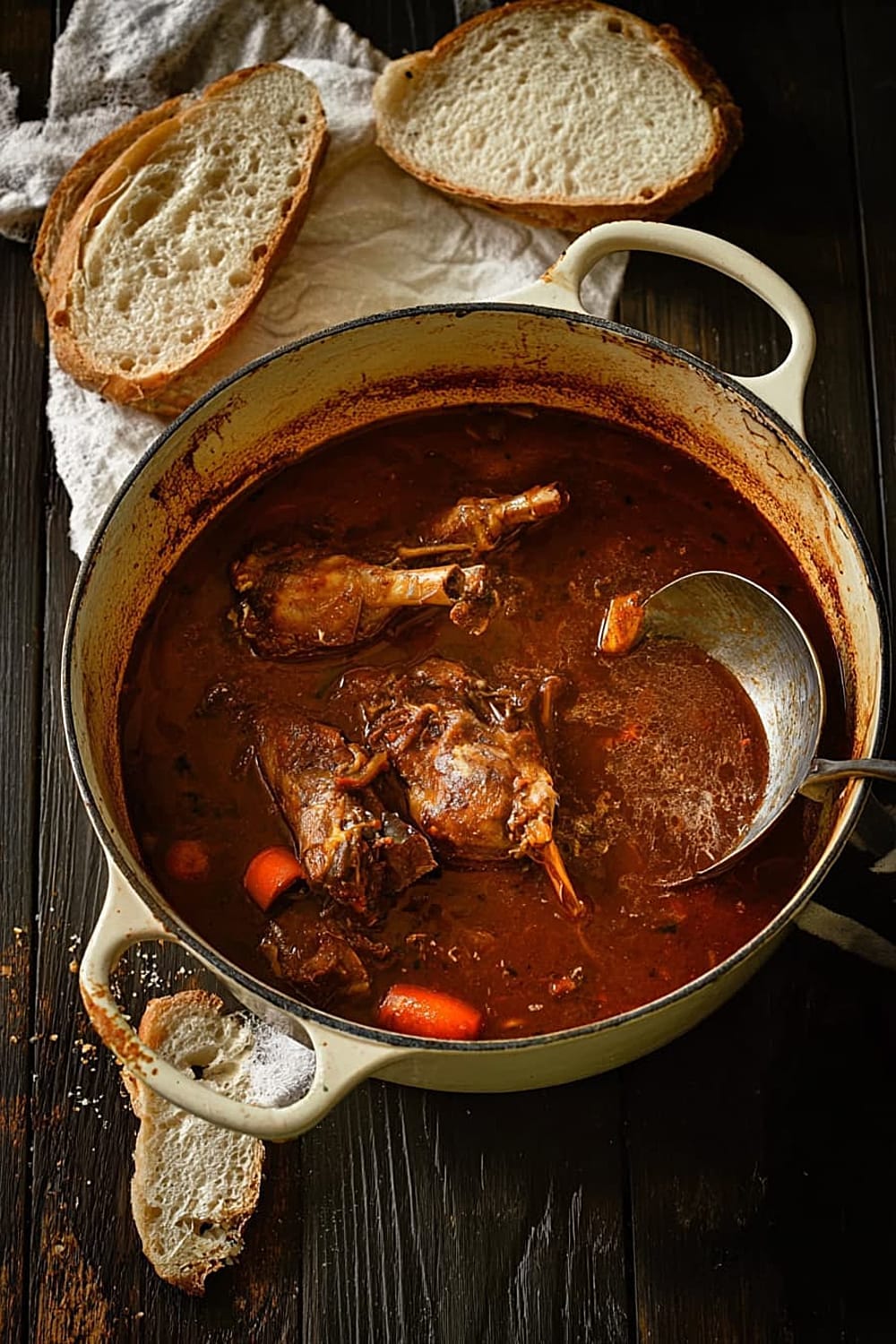
Nutritional Information and Health Benefits
Key Nutritional Highlights:
This medieval rabbit stew provides approximately 320-380 calories per serving (based on 6 servings), with the majority coming from high-quality protein and healthy fats. Rabbit meat is exceptionally lean, containing about 25-30 grams of protein per serving while remaining lower in saturated fat than most red meats. The abundance of vegetables contributes approximately 8-10 grams of fiber per serving, along with complex carbohydrates that provide sustained energy without blood sugar spikes.
Health Benefits of Main Ingredients:
Rabbit meat stands out as one of the healthiest protein sources available, containing all essential amino acids while being naturally low in cholesterol and high in B-vitamins, particularly B12, niacin, and phosphorus. The tomatoes provide lycopene, a powerful antioxidant that becomes more bioavailable through the cooking process, while the carrots contribute beta-carotene for eye health and immune function. Garlic and onions offer sulfur compounds with anti-inflammatory properties, and the olive oil provides heart-healthy monounsaturated fats that aid in the absorption of fat-soluble vitamins from the vegetables.
Dietary Considerations:
This recipe is naturally gluten-free, dairy-free (except for the small amount of butter, which can be substituted), and follows paleo and whole30 guidelines when butter is replaced with additional olive oil. The long braising process breaks down tough fibers, making it easily digestible for most people. Each serving contains approximately 12-15 grams of carbohydrates, primarily from vegetables, making it suitable for low-carb eating patterns.
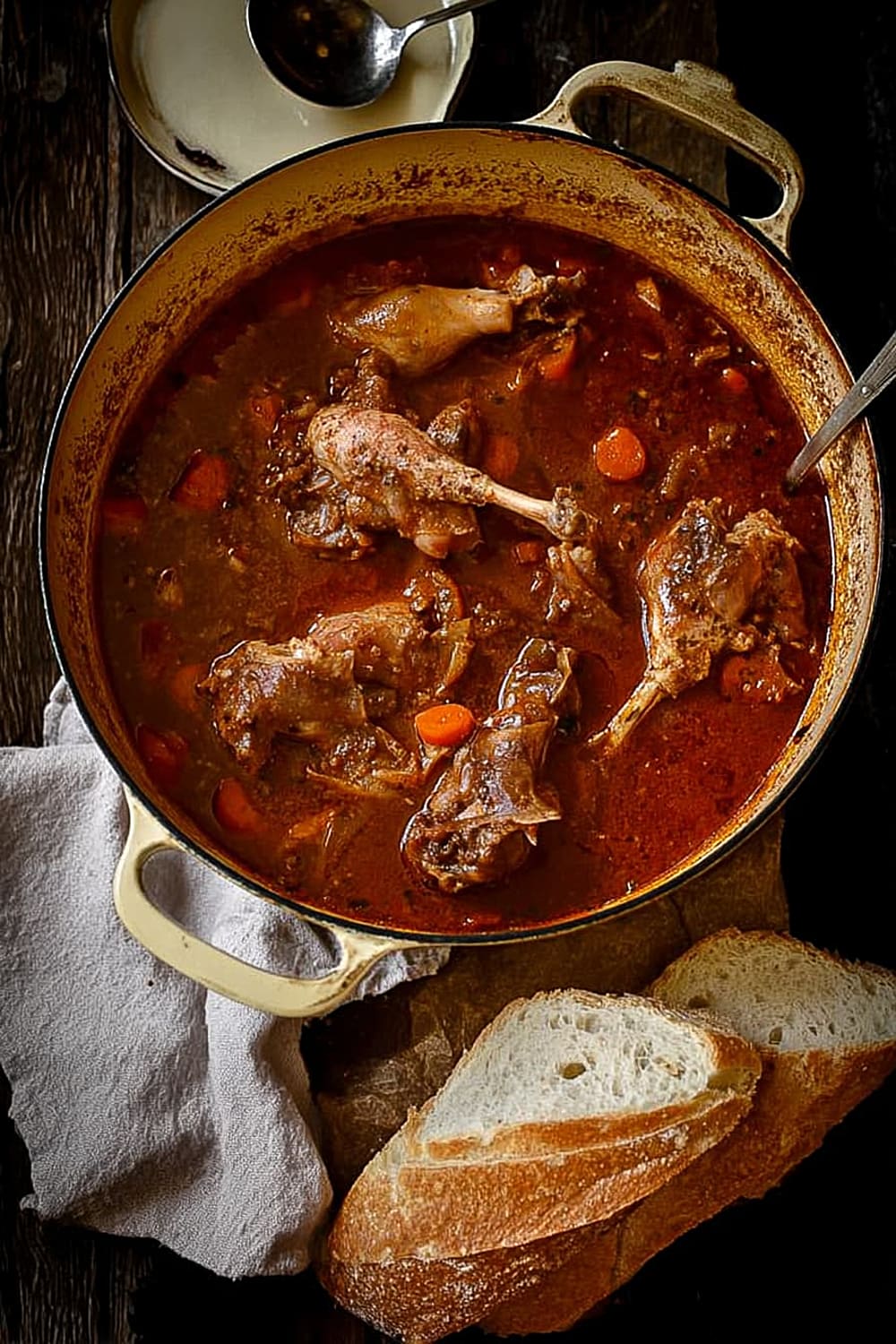
Smart Swaps and Ingredient Substitutions
Common Substitutions:
- Rabbit → 3 lbs chicken thighs (bone-in, skin-on work best), duck legs, or lamb shoulder cut into 2-inch pieces
- White wine → Additional vegetable broth plus 2 tablespoons apple cider vinegar or dry vermouth for similar acidity and depth
- Fresh tomatoes → 1 can (14.5 oz) diced tomatoes, drained, though fresh provides better texture and flavor
- Vegetable broth → Chicken broth, beef broth, or mushroom broth for different flavor profiles
Budget-Friendly Swaps:
- Rabbit → Chicken leg quarters (most economical option while maintaining dark meat richness)
- White wine → White wine vinegar diluted with water (1 part vinegar to 3 parts water) plus a pinch of sugar
- Fresh herbs → Dried herbs using 1/3 the amount (so 1/3 teaspoon dried oregano instead of 1 teaspoon fresh)
Pantry Emergency Substitutions:
- Fresh garlic → 1 1/2 teaspoons garlic powder or 2 tablespoons pre-minced garlic from jar
- Bay leaves → 1/2 teaspoon dried thyme or 1/4 teaspoon ground bay leaves if available
- Tomato paste → 2 tablespoons ketchup mixed with 1 teaspoon vinegar (not ideal but functional)
- Allspice → 1/4 teaspoon each cinnamon, cloves, and nutmeg mixed together
Pro Tips for Substitutions:
- When substituting proteins, maintain similar fat content – lean meats will require additional cooking fat or shorter cooking times
- Store leftover wine in ice cube trays for future cooking use, eliminating waste from opened bottles
- Fresh herbs should be added in the final 10-15 minutes of cooking to preserve their bright flavors and prevent bitterness
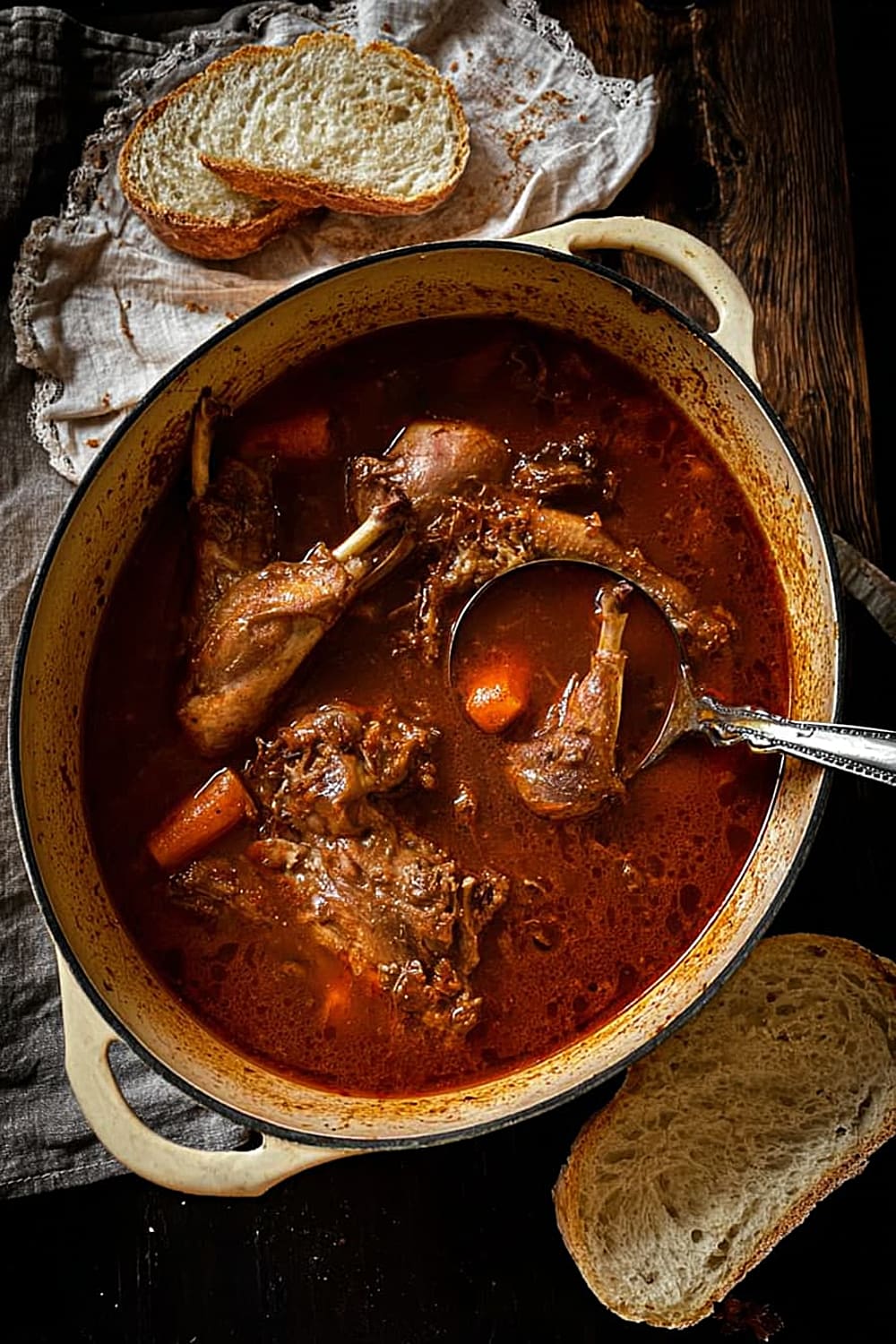
Make It Diabetes-Friendly
Carb Reduction Strategies:
- Reduce carrots → Use only 1 large carrot instead of 3, or substitute with 1 cup radishes or turnips for similar texture with fewer carbs
- Limit tomatoes → Use 3 tomatoes instead of 5, or replace 2 tomatoes with 1 cup bell peppers for bulk without added sugars
- Vegetable broth selection → Choose low-sodium, sugar-free vegetable broth to avoid hidden carbohydrates and excess sodium
Portion & Blood Sugar Management:
- Ideal serving size → 1 1/2 cups per serving provides approximately 8-10 grams net carbs (total carbs minus fiber)
- Protein pairing → The high protein content (25-30 grams per serving) helps slow glucose absorption and promotes satiety
- Timing strategy → Serve with a small side salad dressed with olive oil and vinegar to add fiber and healthy fats that further moderate blood sugar response
Enhanced Nutritional Profile:
- Add extra vegetables → Include 1 cup chopped zucchini or cauliflower florets in the last hour of cooking for additional fiber without significant carb impact
- Herb enhancement → Double the fresh oregano and add 2 tablespoons fresh parsley at serving for extra antioxidants and flavor without carbs
- Healthy fat boost → Drizzle each serving with 1 teaspoon extra virgin olive oil to improve satiety and nutrient absorption
Total Carb Reduction: These modifications reduce carbs from approximately 12-15 grams to 8-10 grams net carbs per serving while maintaining the recipe’s authentic medieval flavors and satisfying nature.
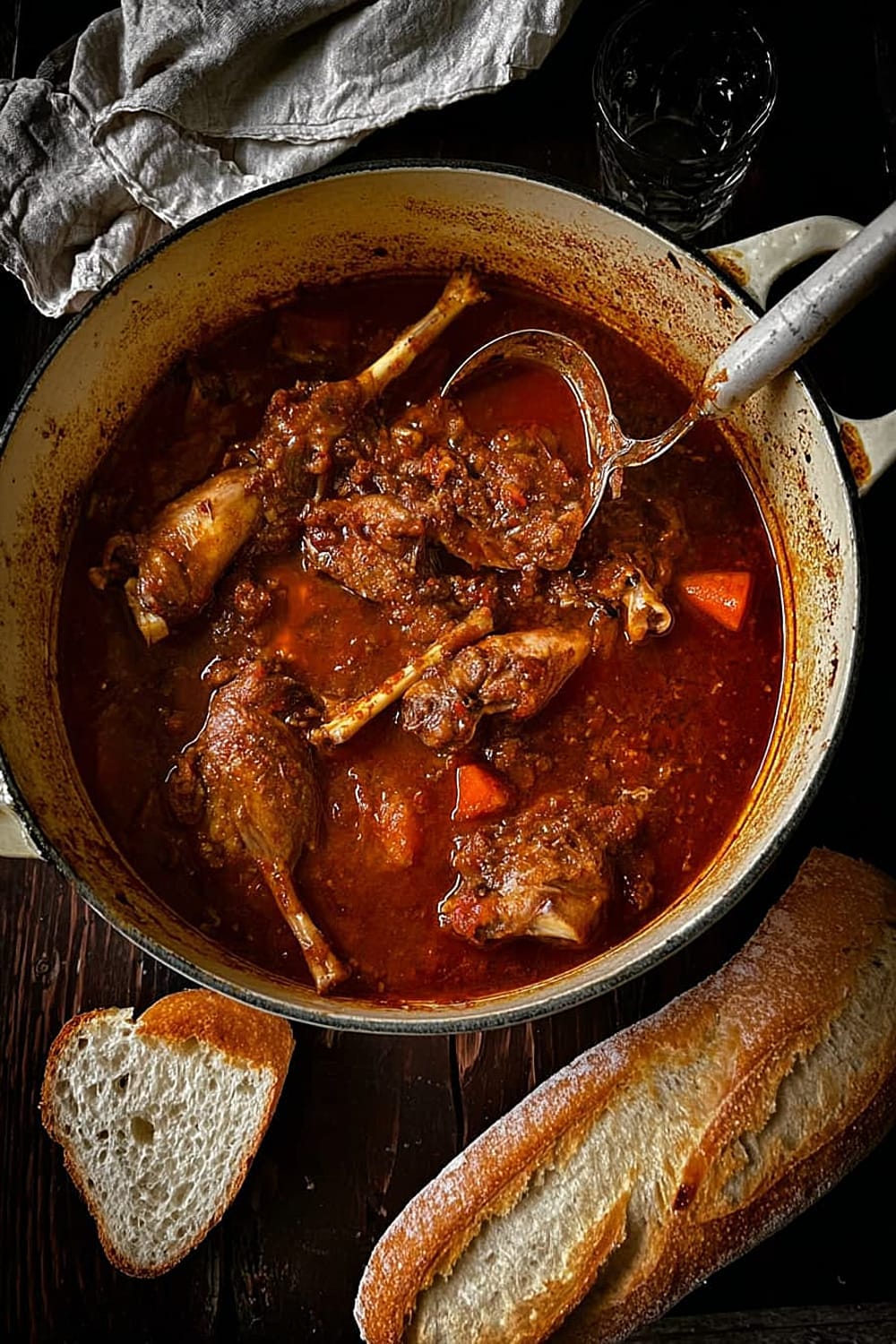
Perfect Pairing Suggestions
Beverage Pairings:
A medium-bodied red wine like Côtes du Rhône or Chianti Classico complements the rabbit’s gamey richness without overwhelming the delicate herb flavors, while the wine’s acidity cuts through the stew’s richness beautifully. For white wine lovers, a full-bodied Chardonnay or white Rioja provides enough weight to stand up to the robust flavors. Beer enthusiasts should reach for a Belgian dubbel or brown ale, whose malty sweetness balances the vinegar’s tang. Non-alcoholic options include sparkling apple cider with rosemary, herbal tea blends featuring sage and thyme, or a rich vegetable broth served warm in mugs as a complementary soup course.
Side Dish Recommendations:
Crusty artisan bread or rustic sourdough serves as the perfect vehicle for soaking up every drop of the precious braising liquid – consider a hearty multigrain or walnut bread for added texture and flavor complexity. Creamy polenta or mashed root vegetables (parsnips mixed with potatoes) provide comforting starch that doesn’t compete with the stew’s medieval character. For lighter accompaniments, roasted Brussels sprouts with bacon, honey-glazed winter squash, or a simple arugula salad dressed with lemon vinaigrette offers fresh contrast to the rich, slow-cooked flavors.
Complete Meal Ideas:
Begin with a simple cheese and charcuterie board featuring aged cheeses, olives, and nuts to set a rustic, European tone. The rabbit stew serves as a perfect centerpiece for cold-weather entertaining, followed by a light dessert like poached pears in red wine or a simple apple tart. For casual family dinners, serve alongside roasted seasonal vegetables and conclude with a warming spice cake or gingerbread cookies that echo the stew’s cinnamon and allspice notes.

Pro Tips and Troubleshooting
Professional Techniques:
Pat the rabbit pieces completely dry before seasoning and browning – excess moisture creates steam instead of the caramelization that builds complex flavors. When browning, resist the urge to move the pieces too frequently; let them develop a proper crust before turning. If your pot isn’t large enough to brown all pieces without crowding, work in batches and set browned pieces aside before continuing. The fond (browned bits) left in the pot after browning is liquid gold – make sure to scrape it up when adding the liquid ingredients, as this adds tremendous depth to the final dish.
Common Mistake Prevention:
Never let the stew reach a rolling boil during the braising phase, as this will toughen the meat fibers instead of breaking them down gently. If you notice the liquid level dropping too quickly, reduce heat further and add warm broth as needed. Don’t skip the initial 20-minute onion and garlic sauté – this foundation of properly caramelized aromatics is crucial for authentic medieval flavor development. Remove bay leaves before serving, as they can be a choking hazard and turn bitter if accidentally bitten.
Storage and Make-Ahead Strategy:
This stew actually improves after a day in the refrigerator, as flavors meld and deepen overnight. Store covered for up to 4 days refrigerated, or freeze portions for up to 3 months in airtight containers. When reheating, do so gently over low heat, adding a splash of broth if needed to restore the proper consistency. The stew can be made entirely ahead and reheated for entertaining, making it perfect for dinner parties where you want to spend time with guests rather than in the kitchen.
Scaling and Presentation:
This recipe doubles beautifully for larger gatherings – just ensure your pot is large enough for proper browning and braising. For elegant presentation, remove the meat and vegetables with a slotted spoon, strain the braising liquid, and serve the clear, intensely flavored broth alongside or over the components. Garnish with fresh oregano leaves and a drizzle of good olive oil for restaurant-quality plating.
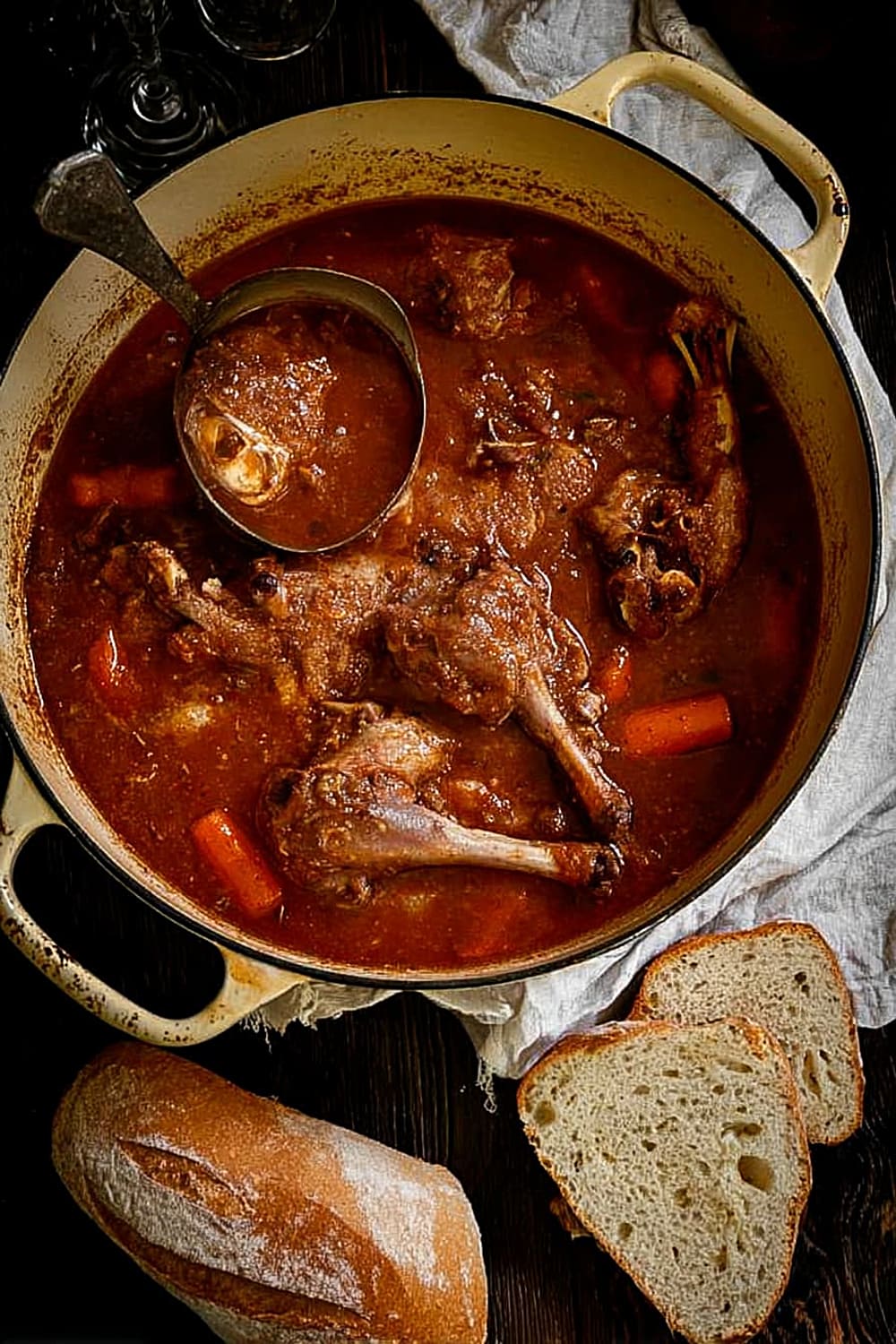
This medieval rabbit stew transforms your kitchen into a cozy tavern where time slows down and every spoonful tells a story of ancient culinary wisdom. The tender meat, rich broth, and aromatic vegetables create a meal that’s both deeply satisfying and surprisingly elegant – proof that some recipes are truly timeless treasures worth the patience they demand.